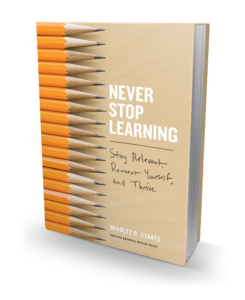Stay Relevant, Reinvent Yourself, and Thrive
Almost every conference I have attended in the last ten years has highlighted the rapid changes that we are experiencing in every aspect of society. Companies need to evaluate digital futures, new technologies, and global strategies. Individuals need to develop plans to keep developing their skills.
How do we best deal with this constant pace of change?
Brad Staats is an associate professor of operations at the University of North Carolina’s Kenan-Flagler Business School. His new book, Never Stop Learning: Stay Relevant, Reinvent Yourself, and Thrive, provides the framework to help all of us become dynamic learners. He says that, “If we fail to learn, we risk becoming irrelevant.”
He also says that we aren’t so great at learning.
I recently spoke with him about his extensive research into learning.
Learning is a Key Differentiator
Why is learning more important today than in past generations?
Learning has always been a key competitive differentiator. What has changed is that things are moving faster and increasingly we are in a winner take all (or at least most) environment. There are four factors I’d highlight that are driving these changes. The first is routinization. Through the use of technology (information and otherwise) we can knock out repeatable tasks. That means our attention can turn to new things where we can innovate. If one looks at job changes in the US over the last 30 years, the data reveals that routine jobs are flat and growth has only occurred in the non-routine settings.
The second driver is specialization. Knowledge around us is increasing, often exponentially. It is estimated a physician would need to read 29 hours a day to stay current on all the necessary knowledge. So we are forced to pick areas to dig in. The third driver is globalization. In the 1990’s, in particular, the global economy opened up as countries like India, Russia, Brazil and China flooded the global labor market with talented individuals. Success is no longer a local affair, it is a global one. Finally, we have digitization. We can capture knowledge digitally and share it around the world. All of these factors mean that great products and services can quickly capture markets and squeeze out others—so we have to learn if we are going to stay relevant. As Microsoft’s CEO, Satya Nadella, has said, “Ultimately, the ‘learn-it-all’ will always do better than the ‘know-it-all.’”
Why are we so bad at learning?
Learning is hard. It demands attention and typically requires taking some risks—and doing new things might not work. But we also have to make sure that we are continuing to deliver as before. We know enough not to work on a jet engine while the aircraft is flying. We don’t have that luxury with learning. We can’t step away from everything to learn and then come back and do. We have to mix it all together. And it turns out that many of our instincts are misaligned. So if we want to be a dynamic learner, then we first have to understand what it is we need to do—then get into why we don’t do those things—before we can come up with new ways to move forward.
Characteristics of a Dynamic Learner
What are a few characteristics of a dynamic learner?
I’ve identified eight elements of dynamic learning. Dynamic learners are:
- Willing to fail to learn.
- Focused on the process, not only the outcome.
- Curious and ask questions rather than rush to answers.
- Able to fight the urge to always act and instead will reflect and relax.
- Comfortable standing out—they do not need to conform.
- Focused on strengths, not on fixing irrelevant weaknesses.
- Conscious of the need to build a T-shaped portfolio of experience that includes both deep specialization in one area (or more than one) and breadth in other areas.
- Willing to learn from others—individual learning is not an individual-only activity.
Focusing on the principles of dynamic learning helps you not only to cope with inevitable change but also to adjust, learn, stay relevant, and excel.
Can you determine whether someone is open to learning? (e.g., say you’re interviewing someone and want to make this determination. How do you best uncover it)?
The direct approach is often the best. At our dinner table each night, we ask our three boys to tell us about something they’ve learned that day. Starting there in an interview can reveal interesting information. But you can’t stop there. Look for evidence of curiosity. For example, asking someone about when they have failed, or what was the last new thing they tried, or when was the last time they did something that made them uncomfortable can all help reveal their willingness to learn.
The Importance of Questions
I was immediately struck by the ‘asking questions’ section which is obviously so critical to learning. As children, this is instinctive. Why, as we mature, may this change?
Anyone who has spent time with a young child sees that this is natural—the constant why, why, why. But it slowly goes away for most of us with time. In part, we have too much to do. We have a “need for speed” as we knock out the things we think we know and move on. The challenge is we may not understand things as well as we thought, plus the world changes around us, and as Marshall Goldsmith noted, “What got you here won’t get you there.” But as we get older we also self-censor. We think others will think less of us when we ask questions. It turns out that research shows that people like others who ask questions. Finally, we sometimes do not realize that we do not need to ask questions. A number of cognitive biases blind us so that. In the words of former Secretary of Defense Robert McNamara, “We see what we want to believe.” We end up missing what is really going on around us.
You point out that confirmation bias may impact our questioning. How do we guard against this?
We have to be willing to constantly ask ourselves why we might be wrong. I love Bob Sutton’s advice to have “strong opinions, weakly held.” In other words, we need to act to move forward, but we should be open to the possibility that new information will present itself that alters our course of action. Others who approach problems differently can help us on this front, too. Along with that openness we need to approach our questions with a falsification mindset. Don’t just think about why we might be wrong, but also what are specific reasons. As we carefully consider the negatives, not just the positives, we build a more complete understanding that helps us to avoid the confirmation bias.
Take Time to Pause
With increased pressure, constant change, and the pace getting faster, it seems that we are unable to recharge and reflect like we should. You point out that we must not be in a state of constant action in order to learn. Why do we refuse to pause?
Research suggests there are four reasons why we refuse to pause. The first is a fear of regret. We want to be seen doing something when we face a challenge, not pausing. There is great research that looks at soccer goalies and penalty kicks. The data suggests that goalies would be more likely to stop kicks if more often they stayed in the middle of the goal, rather than dove. Why do they dive? They want to be seen giving their all—a goalie with a face full of dirt did everything he could. Second, we often confuse action with progress. I’ve done work in the emergency department of hospitals, and we find that as a doctor gets busier, she is more likely to take on an easy patient. Instead of stepping back to think about what we should do, we grab something to knock it out (like many of us might manage our email inboxes). Third, we underestimate the costs of constant action. For example, although only one to three percent of the population can function on five to six hours of sleep, many more people estimate that they can handle it. Finally, we underestimate the gains of pausing. We did research where we gave participants solving a puzzle an opportunity to pause and reflect or keep practicing. Although 80 percent chose to keep practicing, the reflection group actually performed much better. As my dear mentor Dave Upton once told me, “Don’t avoid thinking by being busy.”
I’m fascinated by your discussion of familiarity. Your study concluded that “Teams that had worked together before were dramatically more likely to deliver their projects on time, on budget, and with higher quality.” Would you share more about your research in this area?
 It turns out that familiarity doesn’t breed contempt—it actually helps us perform at a higher level. Familiarity provides several benefits. First, it is motivating. Soldiers will say that they fight for the men on either side of them. Teams work the same way—as we work together we build esprit de corps. Second, as we work repeatedly with individuals, we learn what they know. We also grow more willing to share our information with each other and believe what we learn. I’ve done data-driven research projects looking at software teams and consulting teams and see the same pattern of results—as we work together, we perform at a higher level. We think of individual learning as just that—an individual activity—but we learn better when we build relationships with others.
It turns out that familiarity doesn’t breed contempt—it actually helps us perform at a higher level. Familiarity provides several benefits. First, it is motivating. Soldiers will say that they fight for the men on either side of them. Teams work the same way—as we work together we build esprit de corps. Second, as we work repeatedly with individuals, we learn what they know. We also grow more willing to share our information with each other and believe what we learn. I’ve done data-driven research projects looking at software teams and consulting teams and see the same pattern of results—as we work together, we perform at a higher level. We think of individual learning as just that—an individual activity—but we learn better when we build relationships with others.
For more information, see Never Stop Learning: Stay Relevant, Reinvent Yourself, and Thrive.


